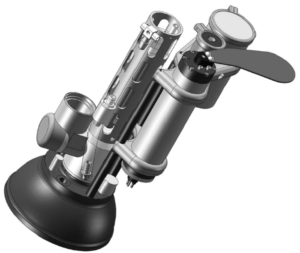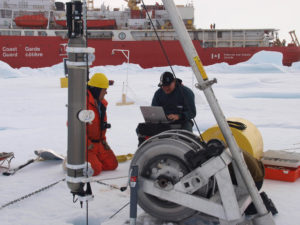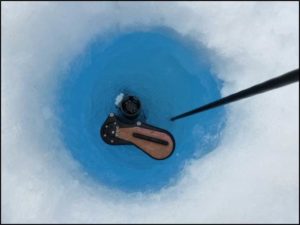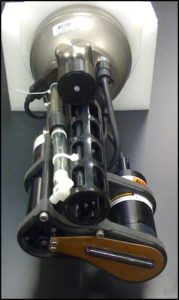Phytoplankton & bio-optics under the ice in the Arctic Ocean
One of the hardest places to study phytoplankton ecology is in those ocean regions that are perennially ice-covered, such as the majority of the central Arctic Ocean. In the Laney Lab we work on new technology for measuring the distribution, seasonality, and interannual variability in phytoplankton assemblages that live under perennial ice cover in polar oceans.
From 2010 to 2015, in collaboration with WHOI's Ice-Tethered Profiler group, we developed and deployed special "bio-ITPs" that can measure bio-optical properties in Arctic under-ice water columns. We developed a special suite of bio-optical sensors that can integrate into standard ITPs and collect useful bio-optical information as these profilers travel along their ~800m wire tethers, anchored in the surface ice. Data from these profilers were relayed to shore via satellite, bringing under-ice observations of algal bio-optics and the under-ice light environment to our lab in near-real-time. In August 2012 one of these profilers (ITP48) became the first to measure an entire year of phytoplankton distributions with daily resolution, under Arctic ice cover in the Transpolar Drift. More information on the initial findings from these deployments can be found in our papers (links to the right).
The units deployed were:
ITP48 Transpolar Drift, deployed 9 Sept 2011, 14 month time series of profiles
ITP52 Beaufort Sea, deployed 5 Aug 2011
ITP60 Transpolar Drift, deployed 8 Sept 2012
ITP64 Beaufort Sea, deployed 28 Aug 2012
ITP65 Beaufort Sea, deployed 27 Aug 2012
ITP68 Beaufort Sea, deployed 26 Aug 2013
ITP69 Beaufort Sea, deployed 27 Aug 2013
ITP72 Transpolar Drift, deployed 30 Aug 2013
Instrumentation
The bio-optical sensor suite for the ITPs include a WETLabs 'triplet' fluorometer custom-engineered to work at 2000m depth, a Satlantic PAR sensor, and an electromechanical shuttering system that protects the optical faces of these two sensors (Satlantic Bioshutter-II). The sensors are mounted on the top endcap of the ITP, adjacent to the standard SBE41CP conductivity-temperature-depth (CTD) sensor. An integrated dissolved oxygen sensor is also part of the measurement complement. Low-power control electronics inside the endcap interface this suite to the ITP main controller and provide an easy serial interface for polling and controlling this suite of sensors and actuator.

Data:
More data from ITP48 and the rest of the bio-optical ITPs can be found on the ITP data portal. Please note that the data on this portal are raw instrument transmissions only, and should not be used for any posters, publications, or other analyses without careful inspection by the end user. Calibration information on the various sensors is provided in a link to the right.
I have done extensive quality control on these profile data and higher grade data sets are available. Researchers interested in using these more fully processed ITP bio-optical data in their research should contact Sam Laney for more information about data format and opportunities to collaborate with these data.
Publications
Laney, S. R., R. A. Krishfield, J. M. Toole, T. R. Hammar, C. J. Ashjian, and M.-L. Timmermans, 2014. Assessing algal biomass and bio-optical distributions in perennially ice-covered polar ocean ecosystems. Polar Sci. 8, 73-85.
Laney, S. R., R. A. Krishfield, and J. M. Toole, 2017. The euphotic zone under Arctic Ocean sea ice: vertical extents and seasonal trends. Limnol. Oceanogr. 62, 1910-1934, doi: 10.1002/lno.1054.

Deployment of an Ice-Tethered Profiler with bio-optical suite. Field engineers rig a tripod to lower a 850m cable through the ice with a weight attached to the end. The bio-optical sensor suite for measuring phytoplankton abundance and other optical properties is visible at the top of the profiler.

The optical sensors on this Ice-Tethered Profiler are just about to submerge beneath the Arctic Ocean for the first and last time. These profilers can last over a year in the ocean, making daily vertical measurements of ocean physics and biology. (Steve Lambert (WHOI))

The bio-optical suite developed for the ITP includes a new self-calibration/self-characterization system which incorporates optical feedback between sensors. This feedback is done by a rigid image conduit embedded in the shutter, which directs excitation light from the triplet fluorometer to the PAR sensor. Decreases in this level of feedback over time indicate a loss in coupling, due to increases in biofouling and/or decreases in the fluorometer output.
Partners/Collaborators
This research is part of WHOI's Ice Tethered Profiler program:
Related Links and Files
- ITP_calibration_data.xlsx
Bio-optical ITP sensor calibration coefficients, spreadsheet form